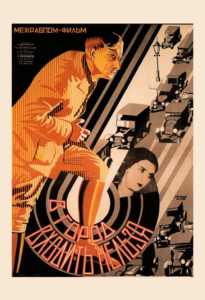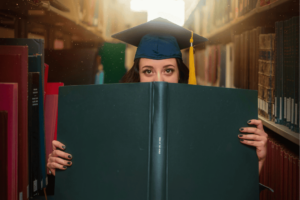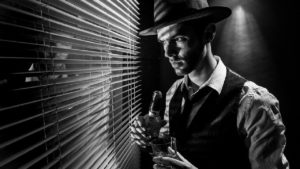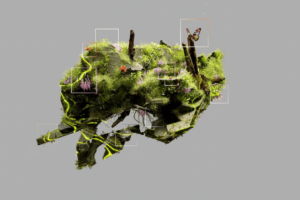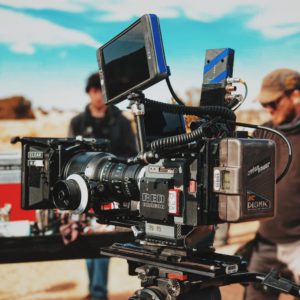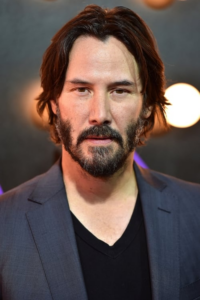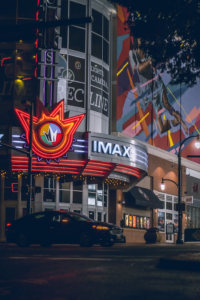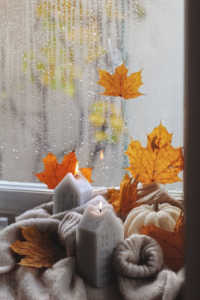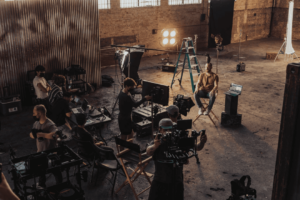A full shot, wide shot, or long shot captures one or more characters or subjects from top to bottom to focus on the character’s appearance or movement. Examples include characters riding horses or walking down the street. Full shots can communicate the appearance, movement, mannerisms, traits, or actions of characters before focusing on their reaction or feelings. For example, to convey fearlessness, you can use a full shot to show a character’s confident stance or walk. Here you can see a full list of 80+ different types of film shots you should know
Similar Types of Shots
It’s best to know common filmmaking shots to understand when to use each one to strengthen the visual effect and story you’re telling with your full shot. Many of these shots occur before or after a full shot, so you should be aware of how each one works.
- Wide shot: Also referred to as long shots, filmmakers shoot this from a distance to emphasize the subjects and how they fit into the surrounding scenery.
- Extreme long shot: Also known as an extreme wide shot, this shows the subjects from a longer distance. You can also use it as an establishing shot, which usually introduces the location at the beginning of a scene.
- Medium long shot: Commonly referred to as a medium-wide shot, it captures the subject from their knees up, positioned between a medium shot and full shot.
- Cowboy shot: This type of medium shot got its start in Western films. It involves framing the camera to capture a character from their head down to the mid-thigh area, leaving enough room for their gun and holster to remain in the shot.
- Close-up: This shot allows your audience to better understand how a character is feeling by framing the camera around their face. This helps the audience determine the characters’ emotions based on certain facial expressions and notice more facial details that may not appear as well in full shots.
- Medium close-up shot: Right between a medium and close-up, this shot typically frames your subject from their head down to either the chest or shoulders. It’s regularly used to show a character’s emotions through their facial expressions or body language.
How To Film a Full Shot
When filming a full shot, you should have a clear view of your character and the environment surrounding them. This helps your audience know where the scene takes place without losing focus on the characters and their actions. Follow these steps to film a full shot that best portrays your film’s message:
Build Your Storyboard
Your film’s storyboard gives you a better idea of how to shoot each scene by visually mapping it out. You can use it to sketch out your idea of what each scene should look like. You can also include relevant notes about a film’s settings or a character and their actions to help you better understand each moment and plot point in the film and which shots might be best to visualize the scene.
Create Your Shot List
Once you prepare your storyboard, create a shot list that details and orders each shot in your film. This allows you to explain your ideal camera placement and angles within each scene. Your camera crew references your shot list to know which equipment to bring while shooting certain scenes. The basic elements of a shot list include:
- Camera angles.
- Camera movements.
- Framing of your camera within each scene.
- Description of the action and characters within the shot.
- Scene numbers.
- Camera equipment needed.
- Scene locations.
- How long camera setup may take and specific setup times.
Frame Your Subjects and Setting in the Shot
As you frame a full shot, position your subjects so their full bodies are in view of the camera while still allowing your audience to see the surrounding environment. This helps your audience understand where the scene takes place and how your character relates to the setting. To capture this, picture your rule of thirds, which is two horizontal and vertical lines evenly breaking up your frame, essentially dividing it into nine squares. As you use the rule of thirds to frame your subjects in a full shot, focus on how to arrange your subjects and scene elements to achieve the balance, or frame composition, you want. A balanced frame entails a certain amount of space dedicated to each element — characters, objects, and background images — in the image. Well-balanced full shots make the film feel more stable, while also helping your audience easily focus on the subject. A great example of a well-balanced full shot is from a scene in the 2019 film, “Joker.” When he’s dancing down the stairs, you see several shots of his full body with the stairs resting behind him. There are many moments when he’s seen on one side of the rule of thirds grid with the stairs filling the space next to him, creating a well-balanced shot.
Block Movement and Action With Actors
Using the rule of thirds, place your subject on one side of the intersecting lines for a visually pleasing look. You should also provide enough leading room, which is the remaining space left in the frame. Your character can use this extra room for motivational movements, like eventually walking toward it or looking and talking to another character offscreen. Blocking and positioning your full shots is good practice before the camera rolls. Actors know when and where to hit their cues and marks, and production crew like camera operators and boom mic operators also know when and where to move to their marks. This practice ensures your full shots are well-composed and clean, which can help viewers stay more engaged in your characters’ struggles, actions, and motivations and conveys the messages you want audiences to take away. For instance, if you place a character on either side of your rule of thirds vertical line, facing the camera, in a well-lit, confident stance, this establishes the character as a likable protagonist. If you’re filming an anti-hero or antagonist, you can place them to the side of your frame in a darker light, showing only parts of their face to portray a more mysterious and dark side to them.
Shoot With Transitions and Cuts in Mind
You can tell your film’s story through transitioning and cutting to different shots. To capture a character’s actions followed by their emotional reactions, you could transition from a full shot into a close-up. This helps establish the character and where they’re located before discovering their feelings and reactions to certain events in the scene. If you want to transition from establishing your location to focusing more directly on your subject, start with an extreme long shot and end with a full shot. Try filming your scenes several times using different variations of shots to learn which one best communicates your film’s message. Continue practicing various poses and placements with your subjects to help them best convey a captivating full shot. To learn how to film the perfect full shot, apply to the Nashville Film Institute to receive training from professional filmmakers.


